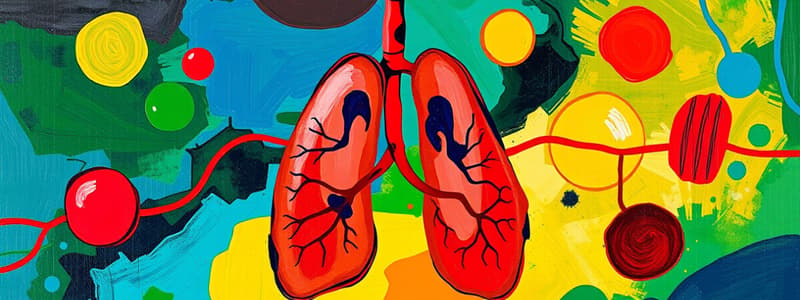Podcast
Questions and Answers
In glycolysis, glucose is converted to?
In glycolysis, glucose is converted to?
pyruvate
The NET result of a single glycolysis run is the formation of?
The NET result of a single glycolysis run is the formation of?
2 NADH and 2 ATP
Under anaerobic conditions, the end product of glycolysis is converted to?
Under anaerobic conditions, the end product of glycolysis is converted to?
lactic acid
During glycolysis, a 6-carbon sugar diphosphate molecule is split into two 3-carbon sugar phosphate molecules.
During glycolysis, a 6-carbon sugar diphosphate molecule is split into two 3-carbon sugar phosphate molecules.
Under aerobic conditions, the end product of glycolysis is further reduced to yield more ATP.
Under aerobic conditions, the end product of glycolysis is further reduced to yield more ATP.
Before entering the citric acid cycle, pyruvate is converted to?
Before entering the citric acid cycle, pyruvate is converted to?
A single 'turn' of the citric acid cycle will yield?
A single 'turn' of the citric acid cycle will yield?
The Krebs cycle occurs in the mitochondria.
The Krebs cycle occurs in the mitochondria.
The initial reaction of the Krebs cycle involves the addition of a?
The initial reaction of the Krebs cycle involves the addition of a?
A single 'turn' of the Krebs cycle involves three different decarboxylation reactions.
A single 'turn' of the Krebs cycle involves three different decarboxylation reactions.
Arrange the following electron acceptors in the proper order in which they participate in electron transport:
Arrange the following electron acceptors in the proper order in which they participate in electron transport:
The electrons that are transferred through the electron transport system initially belonged to?
The electrons that are transferred through the electron transport system initially belonged to?
The movement of protons through ATP synthase occurs from the _________ to the _________.
The movement of protons through ATP synthase occurs from the _________ to the _________.
When oxygen accepts electrons, water is produced as a byproduct.
When oxygen accepts electrons, water is produced as a byproduct.
The production of ATP as a result of the activity of the electron transport system is termed substrate-level phosphorylation.
The production of ATP as a result of the activity of the electron transport system is termed substrate-level phosphorylation.
Flashcards are hidden until you start studying
Study Notes
Glycolysis Overview
- Glycolysis converts glucose into pyruvate.
- A single glycolysis run produces 2 NADH and 2 ATP.
- Under anaerobic conditions, pyruvate is converted into lactic acid.
- A 6-carbon sugar diphosphate is split into two 3-carbon sugar phosphate molecules during glycolysis.
Aerobic vs Anaerobic Conditions
- Under aerobic conditions, pyruvate is converted to acetyl-CoA before entering the citric acid cycle.
- The claim that there is further ATP production from pyruvate under aerobic conditions is false.
Citric Acid Cycle (Krebs Cycle)
- The citric acid cycle occurs in the mitochondria.
- One complete turn of the Krebs cycle yields 1 ATP, 3 NADH, and 1 FADH2.
- The initial step of the Krebs cycle involves adding a 2-carbon molecule to a 4-carbon molecule.
- A single turn of the Krebs cycle does not involve three different decarboxylation reactions.
Electron Transport Chain
- The order of electron acceptors in the electron transport chain is: Cytochrome c, Cytochrome c oxidase, and Oxygen.
- Electrons in the electron transport system initially come from NADH and FADH2.
- Protons move through ATP synthase from the intermembrane space to the mitochondrial matrix.
- Oxygen's acceptance of electrons results in the production of water as a byproduct.
Phosphorylation Types
- The ATP produced from the electron transport system is termed oxidative phosphorylation, not substrate-level phosphorylation.
Studying That Suits You
Use AI to generate personalized quizzes and flashcards to suit your learning preferences.




